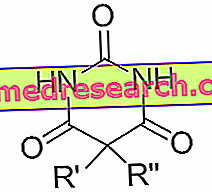Generality
A perianal abscess is a collection of pus located near the anus or in the terminal portion of the rectum. This condition manifests itself as a painful swelling, covered by tense and intensely reddened skin.

Some pathological conditions, such as diverticulitis, colitis or other inflammatory bowel diseases, can make the development of a perianal abscess more likely.
Other predisposing factors are traumas, alterations in the consistency of the stools and the complications of a surgical intervention on haemorrhoids or fissures.
Observation, palpation of the anus and surrounding tissues, and rectal exploration are usually sufficient to diagnose perianal abscess. Surgical therapy is necessary to determine the patient's recovery.
What's this
A perianal abscess represents the acute phase of an infection that originates from microscopic mucus-secreting glands, present between the anal sphincters (ie between the muscles surrounding the anus).
The predisposing factors are varied and include diarrhea and, on the contrary, the passage of very hard stools. Other conditions that favor perianal abscess are some chronic intestinal diseases, such as Crohn's disease and ulcerative colitis, in addition to sequelae of operations on hemorrhoids and fissures. Added to this is the fact that the anal canal and the rectum are anatomical points at high risk of infection, due to the persistent humidity and the numerous organisms present in the faeces.
The perianal abscess is a very painful condition, which can be accompanied by fever and generalized malaise. The collection of pus, placed immediately near the anus, can escape from the skin that contains it, spontaneously or after a surgical incision.
Causes
The perianal abscess is the result of an inflammation, which will determine the collection of pus . The origin of this phlogistic process is the aspecific infection of one of the Hermann and Desfosses glands, placed inside the anal canal and in the terminal portion of the rectal ampulla.
These small anatomical structures are absolutely invisible to the naked eye; their function consists in favoring the passage of the feces, secreting a lubricating mucus in the anal crypts (small depressions in the shape of a swallow's nest that are arranged in the region of the anus in a circular way).
Infection is caused by the penetration of bacteria or foreign material into the gland. For ease of exposure, in fact, this glandular structure has a bottle shape, with the neck facing the lumen of the anal canal. Obstruction of the duct of the gland causes stasis, infection and formation of an abscess.
The pathological process at the base of the perineal abscess can be favored by several factors:
- Local traumas (penetration of foreign bodies, anal eroticism, incorrect execution of enemas, hard fecal bolus, etc.);
- Presence of solid residues in the fecal material wedged in the glandular orifice;
- Alteration of pH or stool consistency (eg diarrheal syndromes, constipation, etc.);
- Anal ulcers;
- proctitis;
- Rectal cancer;
- Inflammatory bowel diseases, such as Crohn's disease, diverticulitis and ulcerative colitis;
- Surgical interventions (episiotomy, hemorrhoidectomy, prostatectomy, etc.);
- Impairment of the immune system;
- Actinomycosis and tuberculosis;
- Sexually transmitted diseases (eg chlamydia, syphilis and venereal lymphogranuloma).
The infection spreads in the tissues using the glandular channels and reaches the perianal skin where, due to the resistance opposed by it, it stops. Immediately under the skin, therefore, all the material produced by the inflammatory process accumulates, then evolving into pus.
Symptoms and complications
The typical symptoms associated with perianal abscess are:
- Localized pain, intense and pulsating, both around the anus and along the rectum;
- Swelling near the anus;
- Reddening of the skin, if the abscess is located near the surface.
These manifestations identify the marked inflammatory nature of the perianal abscess.
The perianal abscess does not immediately manifest itself as a swelling, since the collection of pus represents the final evolution of the clinical picture . Usually, the swelling is felt by the patient in the intermediate and final stages of the pathological process and sometimes is mistaken for a haemorrhoidal thrombosis .
The pain localized in the perianal area tends to increase progressively in a manner directly proportional to the evolution of the abscess, and is exacerbated by palpation and defecation. This symptom can take on a continuous character, so as to induce the assumption of a posture that can somehow alleviate the disorder.
In some cases, it is possible that there are no obvious signs, but digital exploration can reveal a hard and very painful swelling at the level of the rectal wall.
In the presence of a perianal abscess, general symptoms, such as:
- Malaise;
- Temperature;
- Accelerated pulsations.
The infection spreads progressively to the surrounding tissues, forming a channel that connects the anal gland (from which the abscess originates) with the skin of the perianal region, as the pus looks for a way out towards the outside.
The escape of the purulent material is immediately perceived by the patient as a relief of the symptomatology hitherto accused, since the tension of the tissues that contained the infection is reduced. If the laceration of an abscess creates a false passage through the intestine and the skin around the anus, a perianal fistula can result.
When the external orifice of the canal closes (apparent healing), instead, a recurrent abscess can develop and the fever and pain will reappear which reveal the recurrence of the purulent collection.
The perianal abscess and fistula represent two different stages of the same pathology:
- The abscess represents the acute phase of an infection that originates from the mucus-secreting glands present in the anal canal;
- The fistula represents a chronic evolution of this process.
Perianal fistulas cause skin irritation around the anus and itching, which tends to increase during defecation and is typically accompanied by serum-purulent, continuous and foul-smelling secretions, from a small hole located on the skin next to the anus. In some cases, fatigue, fever and pelvic pain may be present.
Diagnosis
The diagnosis is formulated following a visit with rectal exploration.
The perianal abscess can be more or less deep and cross the anal muscles suitable for continence (sphincters), which must be spared during surgical therapy. To better define the relationships of the inflammatory process with the surrounding muscles, the doctor can take advantage of tests, such as transanal ultrasound and MRI.
In the presence of a perianal abscess, the white blood cell count is generally high.
When there is a painful anal swelling, associated with fever, it is important to carry out a proctological examination .
If diagnosed at the right time, the abscess can be treated correctly and promptly.
Therapy
In general, the treatment of any abscess consists essentially in the incision and drainage of the pus collection .
The operation represents a surgical urgency and should be performed as soon as possible to prevent the infection from spreading to other sites.
It should be emphasized that the incision must always be performed when the infection has "organized" in purulent collection, so when this is appreciable.
After treatment, the resolution of acute symptoms is immediate and the analyzes return to normal.
The more superficial abscesses drain under local anesthesia and sedation, while the more complex ones will be treated with spinal or general anesthesia.
Generally, after surgery, a drainage is left in place for a period of time that varies depending on the case. The dressings will then be replaced on a daily basis, then weekly, until the wound is healed.
The administration of antibiotics does not resolve the abscess, but only tends to make it chronic.
Surgical treatment
If it is not yet open to the outside, the skin overlying the perianal abscess must be incised and the cavity is surgically drained to allow the purulent material to escape.
Treatment can be performed in the clinic under local anesthesia, when the abscess is small and not too deep. In the case of bulky or deep abscesses, however, it is necessary to intervene in the operating room after administering a general anesthetic.
In any case, after opening the cavity, medications should be performed regularly, until the affected area has healed.
antibiotic
Antibiotic therapy is not the alternative to surgery, as it can make the clinical picture worse.
Usually, antibiotics are never indicated as a first-line treatment for perianal abscess. In fact, these drugs could make the infectious process chronic and are unlikely to come into contact with the abscess cavity.
For these reasons, the prescription of antibiotics should be reserved for individuals with reduced or elderly immune defenses, in order to prevent distant infections.
Hospitalization and convalescence
After the surgery, the doctor prescribes pain relief therapy, which allows the patient to lead a regular life. At the level of the surgical wound, a gauze may remain, which will be replaced during ambulatory dressings .
If defecation does not occur spontaneously within 2 days, a mild laxative may be given; this act could be accompanied by bright red blood in the faeces, mixed with clots.
Furthermore, after the operation, the patient can observe the following manifestations:
- Pain, anal and rectal burning;
- Red or pink, then yellowish, minor blood loss, even smelly, which lasts until the last incision is completely healed (resolves within 1-3 months);
- Irritation of the skin around the anus, which appears red and causes itching and burning;
- Temporary difficulty in containing the gases due to the dilation of the muscle fibers of the anus (it disappears in about 1 week);
- Fever (up to 38 ° C) in the first days after surgery.
Such situations are to be considered normal and foreseen, therefore they should not cause any concern.
During post-operative recovery, the patient is invited to:
- Wash with plenty of water and betadine soap or euclorine: 2 sachets dissolved in the bidet water, using disposable gloves if necessary;
- Don't sit on the toilet for long;
- Do not use toilet paper (to remove any debris, the shower telephone can be used);
- Use a "donut" to avoid crushing the wound when sitting;
- Avoid long car trips for seven days, while the bicycle and motorcycle should not be used for at least 2 weeks;
- Promote a diet rich in fiber and eliminate alcohol, coffee, chocolate, spices and spicy foods.
Prognosis
About 30% of abscesses recover without further problems. In the remaining part of the cases, however, recurrences may develop after incision and drainage of a perianal abscess. The causes consist mainly of the presence of an underlying fistula or the incomplete drainage of the abscess cable.



